The global electronic packaging adhesives market is valued at USD 293.3 million in 2025 and is set to reach USD 1,068.3 million by 2035, growing at a CAGR of 13.8%. The market stands at the forefront of a transformative decade that promises to redefine electronic device assembly and component bonding excellence across consumer electronics, telecommunications, automotive electronics, and industrial equipment sectors. The market's journey from USD 293.3 million in 2025 to USD 1,068.3 million by 2035 represents exceptional growth, demonstrating the accelerating adoption of advanced adhesive formulations and sophisticated electronic bonding systems across smartphone manufacturing, laptop assembly operations, wireless audio device production, and immersive technology applications.
The first half of the decade (2025 to 2030) will witness the market climbing from USD 293.3 million to approximately USD 559.7 million, adding USD 266.4 million in value, which constitutes 34% of the total forecast growth period. This phase will be characterized by the rapid adoption of high-performance polyurethane and epoxy systems, driven by increasing demand for miniaturization compatibility and enhanced thermal management requirements worldwide. Superior electrical insulation and moisture resistance properties will become standard expectations rather than premium options.
The latter half (2030 to 2035) will witness accelerated growth from USD 559.7 million to USD 1,068.3 million, representing an addition of USD 508.6 million or 66% of the decade's expansion. This period will be defined by mass market penetration of specialized silicone adhesive systems, integration with comprehensive automated assembly platforms, and seamless compatibility with existing surface mount technology infrastructure. The market trajectory signals fundamental shifts in how electronics manufacturers and OEMs approach component attachment solutions, with participants positioned to benefit from sustained demand across multiple technology segments.
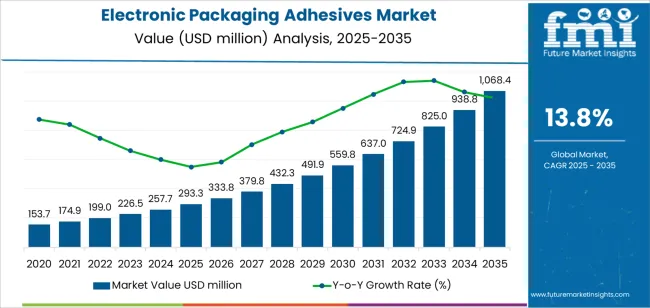
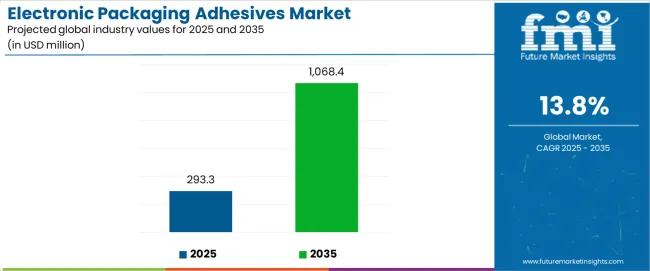
The electronic packaging adhesives market demonstrates distinct growth phases with varying technological characteristics and competitive dynamics. Between 2025 and 2030, the market progresses through its advanced formulation adoption phase, expanding from USD 293.3 million to USD 559.7 million with robust annual increments averaging 13.7% growth. This period showcases the transition from basic thermoplastic adhesives to advanced thermosetting systems with enhanced thermal conductivity and integrated electromagnetic interference shielding becoming mainstream features.
The 2025-2030 phase adds USD 266.4 million to market value, representing 34% of total decade expansion. Market maturation factors include standardization of curing specifications, declining material costs for high-performance formulations, and increasing manufacturer awareness of premium adhesive benefits reaching 80-85% effectiveness in electronic assembly applications. Competitive landscape evolution during this period features established companies like Henkel and Dow expanding their product portfolios while new entrants focus on specialized conductive solutions and enhanced thermal management technology.
From 2030 to 2035, market dynamics shift toward advanced miniaturization and multi-device deployment, with growth accelerating from USD 559.7 million to USD 1,068.3 million, adding USD 508.6 million or 66% of total expansion. This phase transition logic centers on universal high-performance systems, integration with automated pick-and-place equipment, and deployment across diverse electronic scenarios, becoming standard rather than specialized bonding formats. The competitive environment matures with focus shifting from basic adhesion strength to comprehensive thermal management and compatibility with advanced semiconductor packaging operations.
At-a-Glance Metrics
| Metric | Value |
|---|---|
| Market Value (2025) | USD 293.3 million |
| Market Forecast (2035) | USD 1,068.3 million |
| Growth Rate | 13.8% CAGR |
| Leading Adhesive Type | Polyurethane Adhesive |
| Primary Application | Mobile Phones Segment |
The market demonstrates exceptional fundamentals with polyurethane adhesive systems capturing a dominant share through superior flexibility characteristics and temperature-resistant manufacturing capabilities. Mobile phone applications drive primary demand, supported by increasing smartphone production requirements and enhanced component miniaturization solutions. Geographic expansion remains concentrated in Asia Pacific markets with established electronics manufacturing infrastructure, while developed economies show accelerating adoption rates driven by 5G technology projects and rising consumer electronics activity.
Market expansion rests on three fundamental shifts driving adoption across consumer electronics and industrial sectors. Miniaturization advancement creates compelling advantages through electronic packaging adhesive systems that provide comprehensive component bonding with precision dispensing compatibility, enabling manufacturers to achieve smaller device footprints and maintain electrical performance while ensuring reliable assembly operations and justifying investment over traditional mechanical fastening methods. 5G technology deployment accelerates as telecommunications companies worldwide seek advanced bonding systems that deliver thermal management directly to high-frequency operations, enabling heat dissipation that aligns with network equipment expectations and maximizes signal transmission reliability. Consumer electronics evolution drives adoption from device manufacturers requiring durable assembly solutions that maximize component integration while maintaining electrical insulation during operation and environmental exposure.
However, growth faces headwinds from raw material cost fluctuations that differ across polymer suppliers regarding price stability and supply chain reliability, potentially limiting margin consistency in price-sensitive electronics categories. Curing time optimization also persists regarding production speed and assembly throughput that may increase complexity standards in markets with demanding manufacturing protocols.
The electronic packaging adhesives market represents a compelling intersection of electronics manufacturing innovation, polymer chemistry advancement, and component assembly optimization management. With exceptional growth projected from USD 293.3 million in 2025 to USD 1,068.3 million by 2035 at a 13.8% CAGR, this market is driven by increasing miniaturization expansion trends, 5G infrastructure requirements, and consumer demand for reliable electronic formats.
The market's expansion reflects a fundamental shift in how electronics manufacturers and OEMs approach component bonding infrastructure. Strong growth opportunities exist across diverse applications, from mobile phone operations requiring precision component attachment to automotive electronics demanding high-temperature solutions. Geographic expansion is particularly pronounced in Asia-Pacific markets, led by China (18.6% CAGR) and India (17.3% CAGR), while established markets in North America and Europe drive innovation and specialized segment development.
The dominance of polyurethane systems and mobile phone applications underscores the importance of proven adhesive technology and assembly reliability in driving adoption. Curing time and thermal management remain key challenges, creating opportunities for companies that can deliver consistent performance while maintaining process efficiency.
Primary Classification: The market segments by adhesive type into polyurethane adhesive, epoxy resin adhesive, silicone adhesive, and others categories, representing the evolution from basic acrylic formulations to advanced thermosetting formats for comprehensive electronic bonding operations.
Secondary Breakdown: Application segmentation divides the market into mobile phones, TWS headphones, laptops, VR/AR devices, automotive electronics, telecommunications equipment, and others sectors, reflecting distinct requirements for thermal properties, curing characteristics, and electrical performance.
Regional Classification: Geographic distribution covers Asia Pacific, North America, Europe, Latin America, and the Middle East & Africa, with Asia Pacific markets leading growth while developed economies show steady expansion patterns driven by advanced electronics development programs.
The segmentation structure reveals technology progression from standard polyurethane formulations toward integrated multi-functional platforms with enhanced thermal conductivity and electrical insulation capabilities, while application diversity spans from consumer electronics to industrial equipment requiring comprehensive component bonding and environmental resistance solutions.
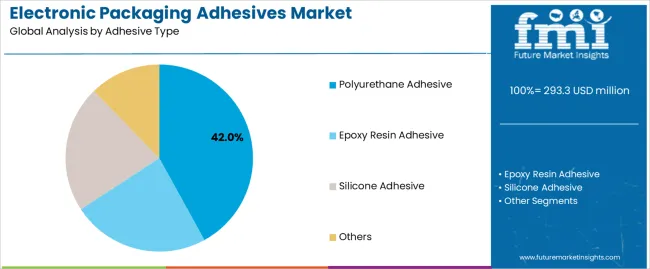
Polyurethane adhesive segment is estimated to account for 42% of the electronic packaging adhesives market share in 2025. The segment's leading position stems from its fundamental role as a critical component in flexible electronics applications and its extensive use across multiple consumer device and industrial electronics sectors. Polyurethane's dominance is attributed to its superior flexibility-to-strength ratio, including excellent vibration resistance, reliable curing properties, and balanced temperature performance that make it indispensable for modern electronic assembly operations.
Market Position: Polyurethane systems command the leading position in the electronic packaging adhesives market through advanced polymer technologies, including comprehensive cure profile control, uniform adhesion formation, and reliable processing performance that enable manufacturers to deploy bonding solutions across diverse electronic environments.
Value Drivers: The segment benefits from engineer preference for proven polymer profiles that provide exceptional durability without requiring extreme curing temperatures. Efficient processing capabilities enable deployment in smartphone assembly, laptop manufacturing, and consumer electronics where flexibility reliability and thermal performance represent critical selection requirements.
Competitive Advantages: Polyurethane systems differentiate through excellent shock absorption, proven moisture resistance, and compatibility with standard dispensing equipment that enhance bonding capabilities while maintaining economical material profiles suitable for diverse electronic assembly applications.
Key market characteristics:
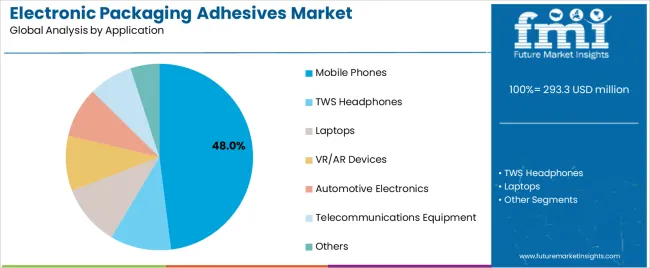
Mobile phones segment is projected to hold 48% of the electronic packaging adhesives market share in 2025. The segment's market leadership is driven by the extensive use of electronic adhesives in smartphone component assembly, display attachment, battery mounting, and circuit board bonding, where adhesive formulations serve as both a structural element and electrical insulation solution. The mobile phone sector's consistent demand for reliable bonding systems supports the segment's dominant position.
Market Context: Mobile phone applications dominate the market due to widespread adoption of advanced smartphone features and increasing focus on device miniaturization, thermal management, and electrical performance that enhance user experience while maintaining durability standards.
Appeal Factors: Electronics manufacturers prioritize precision dispensing, rapid curing, and integration with automated assembly systems that enable coordinated deployment across multiple component attachment needs. The segment benefits from substantial smartphone production growth and technology advancement that emphasize reliable bonding systems for consumer electronics applications.
Growth Drivers: 5G smartphone deployment incorporates electronic adhesives as standard components for antenna mounting and thermal management programs. At the same time, consumer electronics initiatives are increasing demand for premium features that comply with assembly standards and enhance device performance.
Market Challenges: Material cost fluctuations and curing time optimization may limit deployment flexibility in ultra-price-sensitive markets or regions with varying assembly requirements.
Application dynamics include:
Growth Accelerators: Miniaturization advancement drives primary adoption as electronic packaging adhesive systems provide exceptional component bonding capabilities that enable device assembly without electrical interference, supporting performance improvement and manufacturing efficiency that require reliable polymer formats. 5G technology deployment accelerates market expansion as electronics manufacturers seek advanced bonding solutions that maintain signal integrity during high-frequency operation while enhancing thermal dissipation through specialized formulation compatibility. Consumer electronics evolution increases worldwide, creating sustained demand for precision bonding systems that complement automated assembly and provide operational advantages in manufacturing throughput efficiency.
Growth Inhibitors: Raw material price volatility challenges differ across polymer markets regarding cost stability and supply chain consistency, which may limit margin predictability and cost planning in price-sensitive electronics categories with demanding affordability requirements. Processing complexity persists regarding curing parameters and application precision that may increase manufacturing costs in facilities with strict quality control protocols. Market fragmentation across multiple adhesive chemistries and application methods creates compatibility concerns between different assembly systems and existing manufacturing infrastructure.
Market Evolution Patterns: Adoption accelerates in consumer electronics and telecommunications sectors where performance benefits justify material investments, with geographic concentration in Asia Pacific markets transitioning toward mainstream adoption in developed economies driven by advanced technology and electronics development. Technology advancement focuses on enhanced thermal properties, improved dispensing accuracy, and integration with automated assembly systems that optimize bonding performance and production consistency. The market could face disruption if alternative bonding methods or assembly technologies significantly challenge traditional electronic adhesive advantages in component attachment applications.
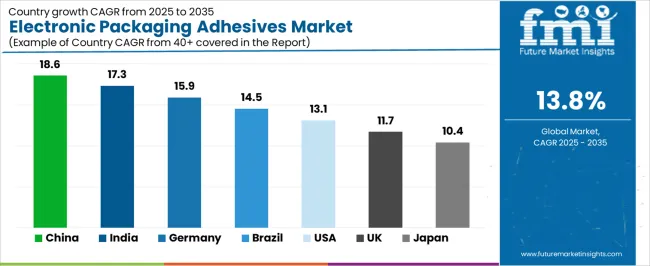
The electronic packaging adhesives market demonstrates varied regional dynamics with growth leaders including China (18.6% CAGR) and India (17.3% CAGR) driving expansion through electronics manufacturing growth and technology infrastructure modernization. Advanced Manufacturing Centers encompass Germany (15.9% CAGR), Brazil (14.5% CAGR), and the USA (13.1% CAGR), benefiting from established electronics industries and premium adhesive adoption.
| Country | CAGR (2025 to 2035) |
|---|---|
| China | 18.6% |
| India | 17.3% |
| Germany | 15.9% |
| Brazil | 14.5% |
| USA | 13.1% |
| UK | 11.7% |
| Japan | 10.4% |
Regional synthesis reveals Asia-Pacific markets leading growth through electronics manufacturing expansion and consumer device development, while European countries maintain strong expansion supported by automotive electronics and industrial applications requirements. North American markets show robust growth driven by telecommunications infrastructure and consumer electronics upgrades.
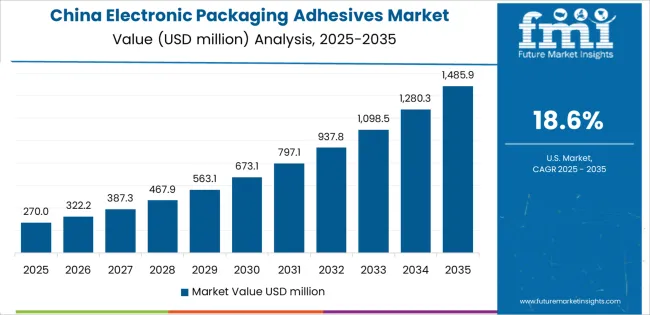
China establishes regional leadership through massive electronics production and comprehensive technology infrastructure modernization, integrating advanced electronic packaging adhesive systems as standard components in smartphone manufacturing and consumer electronics operations. The country's 18.6% CAGR through 2035 reflects manufacturing scale promoting industrial density and technology infrastructure development that mandate the use of reliable bonding systems in electronics assembly operations. Growth concentrates in major manufacturing hubs, including Shenzhen, Shanghai, and Beijing, where electronics networks showcase integrated adhesive systems that appeal to OEMs seeking enhanced assembly efficiency and international quality standards.
Chinese manufacturers are developing innovative electronic adhesive solutions that combine local production advantages with international performance specifications, including high-temperature formulations and advanced thermal conductivity capabilities.
Strategic Market Indicators:
The Indian market emphasizes electronics manufacturing applications, including rapid technology adoption and comprehensive industrial expansion that increasingly incorporates electronic packaging adhesives for mobile phone assembly and telecommunications equipment applications. The country is projected to show a 17.3% CAGR through 2035, driven by massive electronics manufacturing activity under Make in India initiatives and industrial demand for standardized, high-quality bonding systems. Indian electronics facilities prioritize cost-effectiveness with adhesives delivering operational efficiency through economical material usage and reliable performance capabilities.
Technology deployment channels include major manufacturers, electronics companies, and technology developers that support high-volume usage for domestic and export applications.
Performance Metrics:
The German market emphasizes advanced electronic packaging features, including innovative adhesive technologies and integration with comprehensive automation platforms that manage automotive electronics, industrial control systems, and telecommunications applications through unified bonding systems. The country is projected to show a 15.9% CAGR through 2035, driven by industrial expansion under Industry 4.0 development trends and manufacturing demand for premium, reliable bonding systems. German manufacturers prioritize precision with adhesives delivering comprehensive component attachment through enhanced thermal management and operational innovation.
Technology deployment channels include major automotive suppliers, electronics manufacturers, and industrial developers that support custom development for premium operations.
Performance Metrics:
In São Paulo, Rio de Janeiro, and Belo Horizonte, Brazilian electronics facilities and manufacturing operators are implementing advanced electronic packaging adhesive systems to enhance assembly capabilities and support operational efficiency that aligns with technology protocols and production standards. The Brazilian market demonstrates strong growth with a 14.5% CAGR through 2035, driven by electronics manufacturing programs and industrial investments that emphasize reliable bonding systems for consumer electronics and telecommunications applications. Brazilian manufacturing facilities are prioritizing adhesive systems that provide exceptional thermal properties while maintaining compliance with assembly standards and minimizing production complexity, particularly important in consumer electronics manufacturing and automotive electronics operations.
Market expansion benefits from technology programs that mandate enhanced bonding in electronics specifications, creating sustained demand across Brazil's manufacturing and electronics sectors, where thermal management and material consistency represent critical requirements.
Strategic Market Indicators:
The USA market emphasizes advanced electronic packaging applications, including innovative adhesive technologies and integration with comprehensive manufacturing platforms that manage consumer electronics, aerospace systems, and telecommunications infrastructure through unified bonding systems. The country is projected to show a 13.1% CAGR through 2035, driven by technology expansion under 5G infrastructure development trends and manufacturing demand for premium, reliable bonding systems. American electronics facilities prioritize innovation with adhesives delivering comprehensive component attachment through enhanced electrical performance and operational advancement.
Technology deployment channels include major technology companies, aerospace manufacturers, and telecommunications developers that support custom development for advanced operations.
Performance Metrics:
The UK market demonstrates sophisticated electronic packaging adhesive deployment, growing at 11.7% CAGR, with documented operational excellence in consumer electronics and telecommunications applications through integration with existing manufacturing systems and quality assurance infrastructure. The country leverages engineering expertise in polymer chemistry and electronics manufacturing to maintain market competitiveness. Technology centers, including London, Cambridge, and Manchester, showcase advanced installations where adhesive systems integrate with comprehensive assembly platforms and quality control systems to optimize electronics manufacturing and operational efficiency.
British electronics facilities prioritize bonding precision and material consistency in product selection, creating demand for premium electronic packaging adhesive systems with advanced features, including rapid curing formulations and integration with automated dispensing protocols. The market benefits from established technology infrastructure and willingness to invest in specialized adhesive technologies that provide superior thermal properties and regulatory compliance.
Market Intelligence Brief:
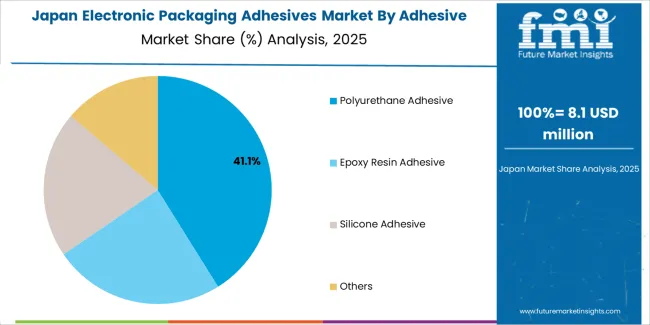
Japan's sophisticated electronics market demonstrates meticulous electronic packaging adhesive deployment, growing at 10.4% CAGR, with documented operational excellence in consumer electronics and automotive applications through integration with existing assembly systems and quality assurance infrastructure. The country leverages engineering expertise in adhesive manufacturing and electronics production to maintain market leadership. Manufacturing centers, including Tokyo, Osaka, and Nagoya, showcase advanced installations where adhesive systems integrate with comprehensive assembly platforms and automation systems to optimize electronics manufacturing and operational efficiency.
Japanese electronics facilities prioritize bonding precision and material consistency in product selection, creating demand for premium electronic packaging adhesive systems with advanced features, including ultra-precise dispensing and integration with robotic assembly protocols. The market benefits from established electronics infrastructure and willingness to invest in specialized adhesive technologies that provide superior electrical properties and regulatory compliance.
Market Intelligence Brief:
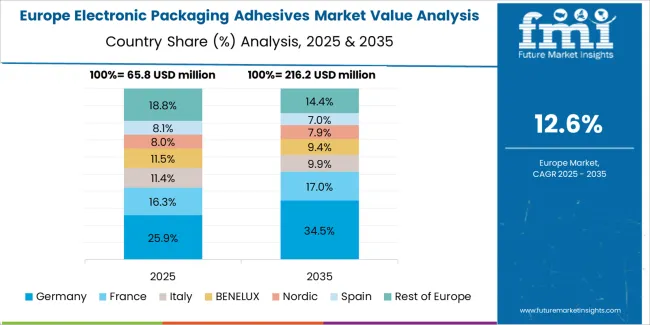
The electronic packaging adhesives market in Europe is projected to grow from USD 42.8 million in 2025 to USD 156.7 million by 2035, registering a CAGR of 13.9% over the forecast period. Germany is expected to maintain its leadership position with a 37.2% market share in 2025, declining slightly to 36.8% by 2035, supported by its automotive electronics excellence and major manufacturing centers, including Baden-Württemberg and North Rhine-Westphalia.
France follows with a 23.1% share in 2025, projected to reach 23.6% by 2035, driven by comprehensive telecommunications programs and aerospace facility initiatives. The United Kingdom holds a 19.7% share in 2025, expected to maintain 20.1% by 2035 through established technology sectors and consumer electronics adoption. Italy commands a 11.4% share, while Spain accounts for 6.8% in 2025. The Rest of Europe region is anticipated to gain momentum, expanding its collective share from 1.8% to 2.7% by 2035, attributed to increasing electronics development in Eastern European countries and emerging technology programs implementing advanced assembly systems.
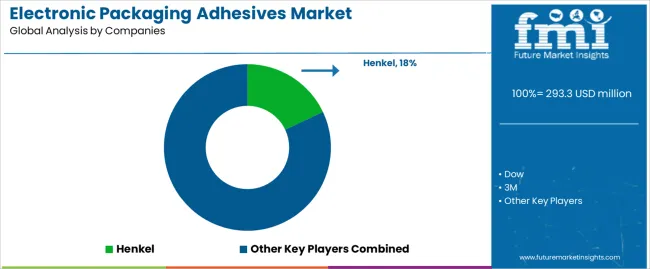
The electronic packaging adhesives market operates with moderate concentration, featuring approximately 15-22 participants, where leading companies control roughly 52-58% of the global market share through established distribution networks and comprehensive technical support capabilities. Competition emphasizes thermal performance, curing efficiency, and electrical properties rather than premium feature rivalry.
Market leaders encompass Henkel, Dow, and 3M, which maintain competitive advantages through extensive adhesive chemistry expertise, global manufacturing networks, and comprehensive application support capabilities that create customer loyalty and support electronics requirements. These companies leverage decades of polymer formulation experience and ongoing technology investments to develop advanced electronic packaging adhesive systems with exceptional thermal conductivity and electrical insulation features.
Specialty challengers include Sika, H.B. Fuller, and Huntsman, which compete through specialized application innovation focus and efficient manufacturing solutions that appeal to electronics buyers seeking reliable performance formats and custom formulation flexibility. These companies differentiate through technical service emphasis and specialized market focus.
Market dynamics favor participants that combine consistent thermal performance with advanced application support, including automated dispensing and quality control capabilities. Competitive pressure intensifies as traditional chemical manufacturers expand into electronic adhesive systems, while specialized electronics materials suppliers challenge established players through innovative polymer formulations and cost-effective production targeting emerging technology segments.
Key Players in the Electronic Packaging Adhesives Market
| Item | Value |
|---|---|
| Quantitative Units | USD 293.3 million |
| Adhesive Type | Polyurethane Adhesive, Epoxy Resin Adhesive, Silicone Adhesive, Others |
| Application | Mobile Phones, TWS Headphones, Laptops, VR/AR Devices, Automotive Electronics, Telecommunications Equipment, Others |
| Regions Covered | Asia Pacific, North America, Europe, Latin America, Middle East & Africa |
| Countries Covered | China, India, Germany, Brazil, USA, UK, Japan, and 25+ additional countries |
| Key Companies Profiled | Henkel, Dow, 3M, Sika, H.B. Fuller, Darbond Technology |
| Additional Attributes | Dollar sales by adhesive type and application categories, regional adoption trends across Asia Pacific, North America, and Europe, competitive landscape with chemical manufacturers and specialty adhesive suppliers, customer preferences for thermal properties and electrical performance, integration with automated assembly equipment and dispensing systems, innovations in polymer chemistry and multi-functional formulations, and development of specialized bonding solutions with enhanced thermal conductivity and moisture resistance features |
The global electronic packaging adhesives market is estimated to be valued at USD 293.3 million in 2025.
The market size for the electronic packaging adhesives market is projected to reach USD 1,068.4 million by 2035.
The electronic packaging adhesives market is expected to grow at a 13.8% CAGR between 2025 and 2035.
The key product types in electronic packaging adhesives market are polyurethane adhesive, epoxy resin adhesive, silicone adhesive and others.
In terms of application, mobile phones segment to command 48.0% share in the electronic packaging adhesives market in 2025.
Electronic Packaging Adhesives Market






Full Research Suite comprises of:
Market outlook & trends analysis
Interviews & case studies
Strategic recommendations
Vendor profiles & capabilities analysis
5-year forecasts
8 regions and 60+ country-level data splits
Market segment data splits
12 months of continuous data updates
DELIVERED AS:
PDF EXCEL ONLINE
Electronic Sealants Market Size and Share Forecast Outlook 2025 to 2035
Electronic Nasal Spray Devices Market Size and Share Forecast Outlook 2025 to 2035
Electronic Expansion Valves Market Size and Share Forecast Outlook 2025 to 2035
Electronic Tactile Tester Market Size and Share Forecast Outlook 2025 to 2035
Electronic Trial Master File (eTMF) System Market Size and Share Forecast Outlook 2025 to 2035
Electronic Wipes Market Size and Share Forecast Outlook 2025 to 2035
Electronic Grade Trisilylamine Market Size and Share Forecast Outlook 2025 to 2035
Electronically Scanned Arrays System Market Size and Share Forecast Outlook 2025 to 2035
Electronics Retailing Market Size and Share Forecast Outlook 2025 to 2035
Electronic Dictionary Market Size and Share Forecast Outlook 2025 to 2035
Electronic Shelf Label Market Analysis - Size, Share, and Forecast Outlook 2025 to 2035
Electronics Films Market Size and Share Forecast Outlook 2025 to 2035
Electronic Payment System For Transportation Market Size and Share Forecast Outlook 2025 to 2035
Electronic Skin Market Analysis - Size, Share, and Forecast Outlook 2025 to 2035
Electronic Ceramics Market Size and Share Forecast Outlook 2025 to 2035
Electronic Equipment Repair Service Market Analysis - Size, Share, and Forecast 2025 to 2035
Electronic Logging Device Market Size and Share Forecast Outlook 2025 to 2035
Electronic Skin Patch Market Size and Share Forecast Outlook 2025 to 2035
Electronic Musical Instruments Market Size and Share Forecast Outlook 2025 to 2035
Electronic Flight Bag Market Size and Share Forecast Outlook 2025 to 2035

Thank you!
You will receive an email from our Business Development Manager. Please be sure to check your SPAM/JUNK folder too.
Chat With
MaRIA